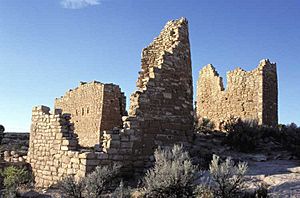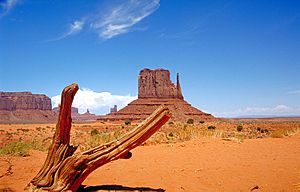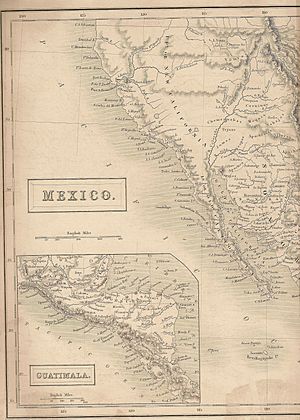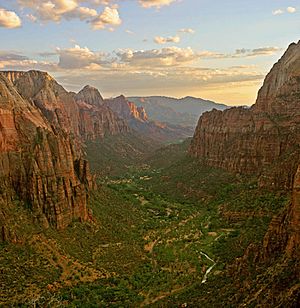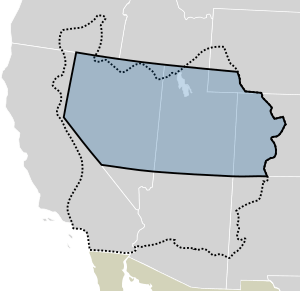History of Utah facts for kids
The History of Utah explores the story of people and events in the state of Utah, located in the western part of the United States.
Scientists believe that the first Native Americans lived in Utah about 10,000 to 12,000 years ago. These early people lived near the swamps and marshes of the Great Basin. They found plenty of fish, birds, and small animals there. Large animals like bison, mammoths, and ground sloths also came to these water sources.
Over time, a new group called the Desert Archaic people arrived. They lived in caves near the Great Salt Lake. These people focused more on gathering food. Their diet included plants like cattails and other salt-loving plants. Meat was less common, but they hunted water fowl, ducks, small animals, and antelope using nets and a tool called an atlatl. They made nets from plant fibers and rabbit skin, woven sandals, and animal figures. Around 3,500 years ago, lake levels rose, and the number of Desert Archaic people seemed to drop a lot. The Great Basin might have been almost empty for 1,000 years.
The Fremont people lived in what is now northern and western Utah, and parts of Nevada, Idaho, and Colorado. They lived there from about 600 to 1300 AD. They lived near water sources, just like the Desert Archaic people before them. However, the Fremont people used new technologies that made them different.
Fremont technologies included:
- Using the bow and arrow for hunting.
- Building pithouses, which were shelters dug partly into the ground.
- Growing maize (corn), and probably beans and squash.
- Building storage buildings (granaries) above ground from adobe or stone.
- Making and decorating simple pottery.
- Creating art, like jewelry and rock art such as petroglyphs (carvings) and pictographs (paintings).
The ancient Puebloan culture, also known as the Anasazi, lived next to the Fremont people. Their culture was centered in the Four Corners area of the Southwest, including the San Juan River region of Utah. This culture started around the year 0 CE, about 500 years before the Fremont appeared. Their culture was strongest around 1200 CE.
Ancient Puebloan culture is known for its well-built pithouses and more complex homes made of adobe and stone. They were skilled artists, making turquoise jewelry and beautiful pottery. The Puebloan culture relied on farming. They grew corn, beans, and squash, and raised turkeys. They also built clever terracing and irrigation systems for their fields. They built special structures called kivas, which were likely used for cultural and religious ceremonies.
These two cultures, Fremont and Puebloan, lived at roughly the same time. They traded with each other and shared some cultural traits. This suggests they might have come from common roots in the early American Southwest. However, they remained distinct cultures. Around 1200 CE, both cultures were greatly affected by climate change and possibly by new groups of people moving into the area. Over the next 200 years, the Fremont and ancient Pueblo people likely moved into the American Southwest. They found new homes and farms in the river areas of Arizona, New Mexico, and northern Mexico.
Around 1200 CE, Shoshonean-speaking peoples entered Utah from the west. They might have come from southern California. They were a mountain people who hunted and gathered food, including roots, seeds, and pinyon nuts. They were also good fishermen, made pottery, and grew some crops. When they first arrived in Utah, they lived in small family groups.
Four main Shoshonean peoples lived in Utah:
- The Shoshone in the north and northeast.
- The Gosiutes in the northwest.
- The Utes in the central and eastern parts.
- The Southern Paiutes in the southwest.
At first, there seemed to be little conflict between these groups.
In the early 1500s, a new group called the Díne or Navajo arrived in the San Juan River basin in Utah's southeast. They were part of a larger group of Athabaskan speakers who moved into the Southwest from the Great Plains. This group also included people later known as Apaches.
The Athabaskans were hunters who followed bison. Spanish accounts from the 1500s called them "dog nomads." The Athabaskans spread out during the 1600s, moving into areas that the Pueblo peoples had left. The Spanish first mentioned the "Apachu de Nabajo" (Navaho) in the 1620s. By the 1640s, the name Navajo was used for these people. The Navajo newcomers generally had peaceful trade and cultural exchange with some Pueblo peoples to the south. However, they sometimes fought with the Shoshonean peoples, especially the Utes in eastern Utah and western Colorado.
When European explorers arrived, starting with the Spanish from Mexico, five main native peoples lived in the Utah area: the Northern Shoshone, the Goshute, the Ute, the Paiute, and the Navajo.
European Explorers Arrive
The Spanish explorer Francisco Vásquez de Coronado might have entered southern Utah in 1540. He was looking for the legendary Cíbola.
In 1776, a group led by two Spanish Catholic priests, known as the Dominguez-Escalante Expedition, left Santa Fe. They hoped to find a route to the California coast. The expedition traveled as far north as Utah Lake and met the native people living there.
Fur trappers, including Jim Bridger, explored parts of Utah in the early 1800s. The city of Provo was named after a trapper named Étienne Provost, who visited in 1825. The city of Ogden, Utah is named after Peter Skene Ogden, a leader of the Hudson's Bay Company who trapped in the Weber Valley. In 1846, a year before the Mormons arrived, the famous Donner party traveled through the Salt Lake Valley. They decided not to stay for the winter and continued on to California.
Mormon Settlers Arrive
Members of The Church of Jesus Christ of Latter-day Saints, known as Mormon pioneers, first arrived in the Salt Lake Valley on July 24, 1847. At this time, the U.S. had already taken the Mexican territories of Alta California and New Mexico during the Mexican–American War. These territories, including the future state of Utah, officially became U.S. territory when the Treaty of Guadalupe Hidalgo was signed on February 2, 1848. The U.S. Senate approved the treaty on March 10, 1848.
When the Mormon pioneers arrived in the Salt Lake Valley, they found no permanent Native American settlements. Other areas along the Wasatch Range were occupied by the Northwestern Shoshone and other Shoshone groups like the Gosiute. The Northwestern Shoshone lived in the valleys near the eastern shore of Great Salt Lake. Years after the Mormons settled, Native Americans asked for payment for the land taken. Heber C. Kimball, a leader in the Mormon church, said the land belonged to "our Father in Heaven." The United States government treated the land as public land and never officially recognized Native American ownership or made a treaty for it.
Building New Communities
When the Mormons arrived in the Salt Lake Valley, they had to build everything from scratch. They created irrigation systems, laid out farms, and built houses, churches, and schools. Access to water was extremely important. Almost immediately, Brigham Young, their leader, began to find and claim more places for communities. It was hard to find large areas in the Great Basin with reliable water and long enough growing seasons for crops. Still, new communities started to form.
Soon after the first group arrived in 1847, the community of Bountiful was settled to the north. In 1848, settlers moved into lands bought from a trapper in what is now Ogden. In 1849, Tooele and Provo were founded. Also that year, at the invitation of Ute chief Wakara, settlers moved into the Sanpete Valley to create Manti. Fillmore, Utah, which was planned to be the capital of the new territory, was started in 1851. In 1855, efforts to share their beliefs with western native cultures led to outposts in Idaho, Las Vegas, Nevada, and Elk Mountain in east-central Utah.
The experiences of soldiers returning from the Mormon Battalion were also important for starting new communities. On their journey west, these Mormon soldiers had found reliable rivers and fertile valleys in Colorado, Arizona, and southern California. As they traveled to rejoin their families in the Salt Lake Valley, they passed through southern Nevada and parts of southern Utah. Jefferson Hunt, a senior Mormon officer, actively looked for settlement sites, minerals, and other resources. His report encouraged settlement efforts in Iron County in 1851, near today's Cedar City. These southern explorations eventually led to Mormon settlements in St. George, Utah, Las Vegas, and San Bernardino, California, as well as communities in southern Arizona.
Impact on Native Americans
Before the Oregon and California trails and Mormon settlement, Native Americans in the Salt Lake Valley hunted buffalo and other game. They also gathered grass seeds and roots. By the time settlers arrived, the buffalo were gone from the valley. Hunting by settlers and grazing by cattle greatly affected the Native Americans in the area. As settlements grew into nearby valleys, native tribes found it harder to find enough food. Brigham Young advised feeding the hungry tribes, which was done, but it was often not enough. These tensions led to the Bear River Massacre by California Militia stationed in Salt Lake City during the Civil War. The massacre site is just inside Preston, Idaho, but was thought to be in Utah at the time.
The Proposed State of Deseret
In 1849-50, the settlers asked to become a state, using the name Deseret. The proposed State of Deseret would have been very large. It would have included all of what is now Utah, and parts of Colorado, Idaho, Nevada, Wyoming, Arizona, Oregon, New Mexico, and California. The LDS leader Brigham Young liked the name Deseret because it meant "honeybee" and symbolized hard work. The name came from the Book of Mormon. Congress rejected the request, and Utah did not become a state until 1896.
Utah Territory is Created
In 1850, the Utah Territory was created as part of the Compromise of 1850. Fillmore was named the capital. In 1856, Salt Lake City became the territorial capital instead.
Slavery in Utah
The first group of pioneers brought African slaves with them. This made Utah the only place in the western United States to have African slavery. They also began to buy Native American slaves from existing trade networks and enslaved Native American prisoners of war. Slavery became officially recognized in 1852 with two laws. However, slavery was ended on June 19, 1862, when Congress banned it in all U.S. territories.
The Utah War
Disagreements between the Mormon settlers and the federal government grew. This happened after The Church of Jesus Christ of Latter-day Saints' practice of polygamy became known. Polygamy, which was made public in 1854, was a major reason Utah was not allowed to become a state for almost 50 years.
After news of polygamy spread, some people saw the Mormons as un-American and rebellious. In 1857, President James Buchanan sent troops on the Utah expedition. Their goal was to calm unrest and replace Brigham Young as governor with Alfred Cumming. This was known as the Utah War.
As fear of invasion grew, Mormon settlers convinced some Paiute Indians to help in an attack on 120 immigrants from Arkansas. This attack was disguised as Native American aggression. The killing of these settlers became known as the Mountain Meadows Massacre. Mormon leaders had created an atmosphere of fear, making settlers distrust outsiders, which led to the attack. Historians still discuss Brigham Young's exact involvement, but generally agree that Mormon leadership approved the attack. Only one man, John D. Lee, was found guilty of the murders and was executed at the massacre site.
News reached Salt Lake City quickly that 2,500 troops were marching west. Fearing the worst, Brigham Young ordered all residents of Salt Lake City and nearby communities to prepare their homes for burning and move south. Young also sent out units of the Nauvoo Legion (the Utah militia) to delay the army. No major fighting happened, but some army supply wagons were captured and burned. The U.S. Army camped near Fort Bridger in Wyoming during the winter of 1857–58. Through talks, control of Utah territory was peacefully given to Alfred Cumming. He entered a mostly empty Salt Lake City in the spring of 1858. The army set up camp 40 miles away from Salt Lake City.
Transcontinental Telegraph
Salt Lake City was the final connection for the First Transcontinental Telegraph. This line connected Carson City, Nevada, and Omaha, Nebraska, and was finished in October 1861. Brigham Young, who helped speed up construction, was among the first to send a message, along with Abraham Lincoln. Soon after, the Deseret Telegraph Company built a local line connecting settlements in Utah with Salt Lake City and the rest of the United States.
Civil War Years
Because of the American Civil War, federal troops left Utah Territory in 1862. General Patrick E. Connor arrived with California Volunteers. Connor and his men were bored and wanted to fight in Virginia. Connor built Fort Douglas near Salt Lake City. He encouraged his men to look for minerals to bring more non-Mormons to the state. Minerals were found in Tooele County, and miners began to arrive.
Connor also dealt with the Shoshone Native American "problem" in Cache Valley Utah. On January 29, 1863, he lured the Shoshone into a winter fight. The conflict quickly turned into a massacre. Between 200 and 400 Shoshone men, women, and children were killed. 27 soldiers also died, and over 50 were wounded or suffered from frostbite. This event is known as the Bear River Massacre.
Starting in 1865, Utah's Black Hawk War became the deadliest conflict in the territory's history. Chief Antonga Black Hawk died in 1870, but fighting continued until more federal troops were sent in 1872. This war was unusual because it involved three groups: mounted Timpanogos Utes led by Antonga Black Hawk, and federal and Utah local militia.
On May 10, 1869, the First Transcontinental Railroad was completed at Promontory Summit, north of the Great Salt Lake. The railroad brought more people into the state, and several business owners became wealthy.
Polygamy and Statehood
During the 1870s and 1880s, federal laws were passed to stop polygamy. Federal marshals were sent to enforce these laws. In the 1890 Manifesto, the LDS Church leadership announced they would no longer approve of polygamy, saying it was a divine revelation. When Utah applied for statehood again in 1895, it was accepted. Utah officially became a state on January 4, 1896.
Women's Right to Vote
The issue of polygamy made the situation for women in Utah a national topic. In 1870, the Utah Territory, controlled by Mormons, gave women the right to vote. However, in 1887, Congress took away this right with the Edmunds–Tucker Act. This law was meant to weaken the Mormons politically and punish them for polygamy. From 1867-1896, activists from the East promoted women's right to vote in Utah. They saw it as a way to end polygamy. Mormons also supported women's suffrage to improve the image of Mormon women. With the 1890 Manifesto, Utah was able to pursue statehood. In 1895, Utah adopted a constitution that restored women's right to vote. Congress admitted Utah as a state with that constitution in 1896.
Utah in the 1900s and 2000s

In the early 1900s, with the creation of national parks like Bryce Canyon National Park and Zion National Park, Utah became known for its natural beauty. Southern Utah became a popular place to film movies with dry, rugged landscapes. Natural landmarks like Delicate Arch and "the Mittens" in Monument Valley are easily recognized by many people. During the 1950s, 1960s, and 1970s, the building of the Interstate highway system made it easier to reach these beautiful southern areas.
Starting in 1939, with the opening of Alta Ski Area, Utah became famous worldwide for its skiing. The dry, powdery snow in the Wasatch Range is considered some of the best for skiing anywhere. Salt Lake City won the bid to host the 2002 Winter Olympics in 1995. This greatly boosted the economy. The ski resorts became even more popular, and many Olympic venues are still used for sporting events. This also led to the development of the light-rail system in the Salt Lake Valley, called TRAX, and the rebuilding of the freeway system around the city.
In the late 1900s, the state grew quickly. In the 1970s, growth in the suburbs was huge. Sandy was one of the fastest-growing cities in the country then. West Valley City is now the state's second most populated city. Today, many areas of Utah are growing very fast. Northern Davis, southern and western Salt Lake, Summit, eastern Tooele, Utah, Wasatch, and Washington counties are all expanding quickly. Transportation and urbanization (cities growing) are big political issues as development uses up farmland and wild areas.
In 2012, the State of Utah passed a law to try and gain control over a large part of federal land in the state from the federal government. This was based on language in the Utah Enabling Act of 1894. The state plans to use education, talks, new laws, and if needed, legal action to gain state or private control over these lands after 2014.
See also
 In Spanish: Historia de Utah para niños
In Spanish: Historia de Utah para niños



